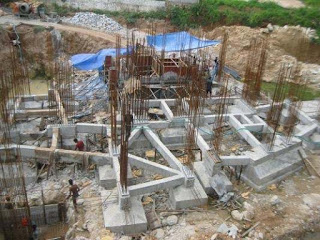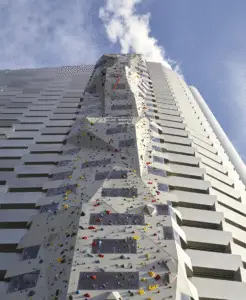Basic difference between plinth beam and tie beam is that tie beam can be at any level but plinth beam is at plinth level.
So Now i am going to discuss in depth about the following contents :-
Contents
- What is the purpose of beam in a Building?
- What is plinth level in building?
- What is plinth beam?
- Types of plinth beam
- Purpose of plinth beam
- Plinth beam height
- What is tie beam?
- Purpose of tie beam
- Difference between plinth beam and tie beam?
- Design of tie beam
- Tie beam construction
- Plinth beam construction
- Height of Tie Beam
- Foundation tie beam
- Is plinth beam necessary?
Subscribe Us on YouTube!
What is purpose of beam in building?
Beam as we all know is a 2d structural element of a structure either a frame structure or a beam supported structure.
The basic purpose of providing a beam is to transfer the imposed load both dead and live to a wall or column whatever is designed on the basis of structural requirement of a building.
Beams are meant to resist bending or flexural stresses as a major one with shear stresses as minor ones.
The reason and/or purpose for providing a beam in a building is to span a gap or to have some space or opening like that of a door or a window.
 |
| What is purpose of beam in building? |
What is plinth level in building?
Plinth level is basically the level of the ground floor top which is usually kept higher than the ground level. By ground level we mean the natural surface level while the ground floor level is the surface finish level of the inner part of the building.
The reason to make plinth level a bit higher than the ground level is to prevent the rain or other runoff water from coming inside the building and on the other hand provide sufficient drainage to the surface water of the building.
The extent of level is decided keeping in the view the future trends in the locality like raising of the road level etc.
What is Plinth Beam?
Now you know what plinth level is; as for the plinth beam, in simple words, it is the beam at the plinth level.
Plinth beam in a frame structure is meant to join all the columns thereby reducing the effective length and thus reducing the slenderness of the columns.
Types of Plinth Beam
Well the plinth beam is actually a band beam i.e. it runs throughout the periphery of the structure at plinth level and is mostly reinforced with minimum 2 main rebars at top and 2 rebars at bottom with minimum diameter of 10 mm. To avoid shrinkage shear failures in plinth beam stirrups of minimum #3 are used at 150 mm spacing.
Purpose of Plinth beam?
Plinth beams are usually used in case the foundations are bit deeper and thus they act like a bracing or tying element.
One more reason to provide plinth beam is to avoid differential settlement in a building this is due to the reason that all the load of the wall is than carried by the plinth beam underneath.
In a skeletal system which is the other name of a framed structure; plinth beam is the first beam to be constructed after foundation.
As the finish floor level of the ground floor is a kept higher than the ground level; the empty gap and void is filled with a compacted soil so as to achieve a stable surface for the floor to be constructed.
The plinth beam is usually expected to be strong enough to carry the superimposing brick wall as well tying the columns and the structure.
Keeping in view the structural requirement of a building; plinth beam can either be reinforced or non-reinforced.
However, usually these days plinth beam is reinforced which is also recommended as per the seismic codes of certain countries.
Plinth Beam height
Well this is a very interesting question because there are a lot of factors that are to be considered for deciding the ideal height of plinth beam. The two major factors you must consider while deciding the plinth height for your building are –- Road level
- Re-carpeting cycles of pavement in your area.
Mostly the natural ground level of the plot are deeper than the road highway level so if the plinth is not provided the plot would be mostly immersed in water until dried naturally by sun. So keeping in view the road surface runoff level and draining condition of your area you must decide such a level which would make your house safe from any runoff from surroundings.
In most municipalities the overlaying of concrete local roads is usually done after a year or so without chipping off the original road surface so you must decide such a height for your plinth so that any re-carpeting may not effect your house from dampness and surface runoff.
What is Tie Beam?
Tie beam in structural engineering is like a primary beam which connects two columns at any height above the floor level.
Difference between Tie Beam and Plinth beam
As for the tie beam; you will be amazed to read that plinth beam is actually called a tie beam. Actually the word tie beam is a broader term; one type of tie beam is a plinth beam. The main difference between a tie beam and plinth beam is the \”elevation\” at which the beams are provided. The plinth beam is provided at plinth level while tie beam is provided somewhere above plinth level and floor level.
Purpose of Tie Beam
Tie beams are meant to act as a length breaker for the columns to reduce their effective length and reducing slenderness ratio in case the roof height is bit more.
Tie beams are also different from primary and secondary beam. Primary and secondary beam in a frame structure carries the load of a floor, whereas tie beam does not take the load of any floor and only takes the load of wall.
Design of Tie Beam
The tie beams are designed to carry the superimposed load of the walls either brick or blocks above and also the different settlement load of the building.
Height of Tie Beam
A tie beam is usually recommended for a column when its height is more than 4 to 5 meters. However, the designer must keep in check the bending length of the column to make them non slender.
Have you ever thought why the foot-rest is provided in a chair? It is actually meant to tie the four legs of the chair so as to reduce the opening or the dispatching force within the legs of the chair.
I hope you are now able to answer what is the difference between plinth beam and a tie beam along with some bonus questions like what is plinth level; what are primary beams; what are secondary beams. You have also understood why the plinth beam is provided and why the tie beam is provided. What is the effect of the tie beam on the columns or what is the effect of the plinth beam on the columns.
Foundation Tie Beams
Have your ever heard of a strap footing? Strap footing arrangement is mostly used when the columns are eccentric due to property restriction. So in order to avoid the extra moment due to eccentricity of columns a tie beam is provided which connects two isolated footings. This type of tie beam is also called a strap beam. The horizontal main reinforcement of strap beams are developed into the isolated footings and the level of strap tie beam is slightly higher than the foundation level of the footing.
Tie beam & Plinth Beam construction
What is Lintel Beam?
While reading about the plinth beam does not get confused about the lintel beam also; lintel beam is meant to have a clear space for the window to be constructed or for the opening of a door.
Lintel beam is a comparitively thin horizonal member which is provided on the openings in walls like windows, doors etc so as to carry the load of the wall above the opening and transfer it to the sides of the opening. Sometimes a band lintel beam is also provided in some buildings if the lintel level of all the building openings are uniform.
Types of Lintel beams
There are different types of lintel beams used on the basis of strength and servicaiblity requirements such as :-
Reinforced concrete lintels
steel lintels
reinforced brick lintels
stone lintels
timber lintels
prestressed lintels
Purpose of Lintel Beam
One purpose of providing lintel beam is also to make the building sustainable in case of seismic effects. As the weight of the brickwork above the opening is transfered directly to the lintel beams and as the opening area is a comparitively weaker area where cracks and ultimate failure may occur in the absense of lintel beam. Lintel beams can also be decorative, load-bearing or a combined ornamental structural beam.
Is plinth beam necessary?
What next?
If you think I have missed anything related to what is the difference between plinth beam and a tie beam than do comment it below so that we can have a healthy discussion about such an important question about structures.














This comment has been removed by a blog administrator.
This comment has been removed by a blog administrator.
Its a beautiful shearing.Can we use polythin sheet under the plinth beam to isolate it from the gird wall under the plinth beam. So that if the gird wall gets lower down over time the plinth beam will still be in position.Please Reply .
Its a beautiful shearing.Can we use polythin sheet under the plinth beam to isolate it from the gird wall under the plinth beam. So that if the gird wall gets lower down over time the plinth beam will still be in position.Please Reply .
Actually the polytin sheet will work only for avoidance of dampness and is a good choice but mostly in cases where plinth level is bit higher than the road level the dpc is not needed.
Actually the polytin sheet will work only for avoidance of dampness and is a good choice but mostly in cases where plinth level is bit higher than the road level the dpc is not needed.